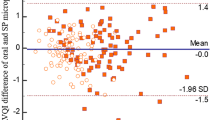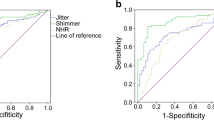Abstract
Purpose
The aim of the study was to investigate and compare the feasibility and robustness of the Acoustic Voice Quality Index (AVQI) and the Dysphonia Severity Index (DSI) in diagnostic accuracy, differentiating normal and dysphonic voices.
Methods
A group of 264 subjects with normal voices (n = 105) and with various voice disorders (n = 159) were asked to read aloud a text and to sustain the vowel /a/. Both speech tasks were concatenated, and perceptually rated for dysphonia severity by five voice clinicians. They rated the Grade (G) and the overall dysphonia severity with a visual analog scale (VAS). All concatenated voice samples were acoustically analyzed to receive an AVQI score. For DSI analysis, the required voice parameters were obtained from the sustained phonation of the vowel /a/.
Results
The results achieved significant and marked concurrent validity between both auditory-perceptual judgment procedures and both acoustic voice measures. The DSI threshold (i.e., DSI = 3.30) pertaining to Gmean obtained reasonable sensitivity of 85.8% and specificity of 83.4%. For VASmean, the DSI threshold of 3.30 was determined also with reasonable sensitivity of 70.3% and excellent specificity of 93.9%. Also, the AVQI threshold (i.e., AVQI = 3.31) pertaining to Gmean demonstrated reasonable sensitivity of 78.1% and excellent specificity of 92.0%. For VASmean, an AVQI threshold of 3.33 was determined with excellent sensitivity of 97.0% and reasonable specificity of 81.8%.
Conlusion
The outcomes of the present study indicate comparable results between DSI and AVQI with a high level of validity to discriminate between normal and dysphonic voices. However, a higher level of accuracy was yielded for AVQI as a correlate of auditory perceptual judgment suggesting a reliable voice screening potential of AVQI.



Similar content being viewed by others
References
Maryn Y, Roy N, De Bodt M et al (2009) Acoustic measurement of overall voice quality: a meta-analysis. J Acoust Soc Am 126:2619–2634. https://doi.org/10.1121/1.3224706
Roy N, Barkmeier-Kraemer J, Eadie T et al (2013) Evidence-based clinical voice assessment: a systematic review. Am J Speech Lang Pathol 22:212–226. https://doi.org/10.1044/1058-0360(2012/12-0014)
Linder R, Albers AE, Hess M et al (2008) Artificial neural network-based classification to screen for dysphonia using psychoacoustic scaling of acoustic voice features. J Voice 22:155–163. https://doi.org/10.1016/j.jvoice.2006.09.003
Uloza V, Verikas A, Bacauskiene M et al (2011) Categorizing normal and pathological voices: automated and perceptual categorization. J Voice 25:700–708. https://doi.org/10.1016/j.jvoice.2010.04.009
Wuyts FL, De Bodt MS, Molenberghs G et al (2000) The dysphonia severity index: an objective measure of vocal quality based on a multiparameter approach. J Speech Lang Hear Res 43:796–809. https://doi.org/10.1044/jslhr.4303.796
Hussein Gaber AG, Liang FY, Yang JS et al (2014) Correlation among the dysphonia severity index (DSI), the RBH voice perceptual evaluation, and minimum glottal area in female patients with vocal fold nodules. J Voice 28:20–23. https://doi.org/10.1016/j.jvoice.2013.08.002
Nemr K, Simões-Zenari M, de Souza GS et al (2015) Correlation of the Dysphonia Severity Index (DSI), Consensus Auditory-Perceptual Evaluation of Voice (CAPE-V), and gender in Brazilians with and without voice disorders. J Voice 30:765e7–765e11. https://doi.org/10.1016/j.jvoice.2015.10.013
Hakkesteegt MM, Brocaar MP, Wieringa MH (2010) The applicability of the dysphonia severity index and the voice handicap index in evaluating effects of voice therapy and phonosurgery. J Voice 24:199–205. https://doi.org/10.1016/j.jvoice.2008.06.007
Salmen T, Ermakova T, Möller A et al (2017) The value of vocal extent measure (VEM) assessing phonomicrosurgical outcomes in vocal fold polyps. J Voice 31:114.e7–114.e15. https://doi.org/10.1016/j.jvoice.2016.03.016
Maryn Y, De Bodt M, Roy N (2010) The Acoustic Voice Quality Index: toward improved treatment outcomes assessment in voice disorders. J Commun Disord 43:161–174. https://doi.org/10.1016/j.jcomdis.2009.12.004 doi
Maryn Y, Corthals P, Van Cauwenberge P et al (2010) Toward improved ecological validity in the acoustic measurement of overall voice quality: combining continuous speech and sustained vowels. J Voice 24:540–555. https://doi.org/10.1016/j.jvoice.2008.12.014
Awan SN, Roy N, Dromey C (2009) Estimating dysphonia severity in continuous speech: application of a multi-parameter spectral/cepstral model. Clin Linguist Phon 23:825–841. https://doi.org/10.3109/02699200903242988
Awan SN, Roy N, Zhang D, Cohen SM (2016) Validation of the cepstral spectral index of dysphonia (CSID) as a screening tool for voice disorders: development of clinical cutoff scores. J Voice 30:130–144. https://doi.org/10.1016/j.jvoice.2015.04.009
Maryn Y, De Bodt M, Barsties B, Roy N (2014) The value of the acoustic voice quality index as a measure of dysphonia severity in subjects speaking different languages. Eur Arch Otorhinolaryngol 271:1609–1619. https://doi.org/10.1007/s00405-013-2730-7
Barsties B, Maryn Y The improvement of internal consistency of the Acoustic Voice Quality Index. Am J Otolaryngol 36:647–656. https://doi.org/10.1016/j.amjoto.2015.04.012
Barsties B, Maryn Y (2012) The Acoustic Voice Quality Index. Toward expanded measurement of dysphonia severity in German subjects. HNO 60:715–720. https://doi.org/10.1007/s00106-012-2499-9
Reynolds V, Buckland A, Bailey J et al (2012) Objective assessment of pediatric voice disorders with the acoustic voice quality index. J Voice 26:672.e1–672.e7. https://doi.org/10.1016/j.jvoice.2012.02.002
Uloza V, Petrauskas T, Padervinskis E et al (2017) Validation of the Acoustic Voice Quality Index in the Lithuanian language. J Voice 31:257.e1–257.e11. https://doi.org/10.1016/j.jvoice.2016.06.002
Kankare E, Barsties B, Maryn Y, Ilomäki I, Laukkanen AM, Tyrmi J, Rantala L, Asikainen M, Rorarius E, Siirilä MVS (2015) A preliminary study of the Acoustic Voice Quality Index in Finnish speaking population. A Prelim. study Acoust. Voice Qual. Index Finnish Speak. Popul. 11th Pan European Voice Conference; 2015 August 31th–September 4th. Florence, p 218
Maryn Y, Kim H-T, Kim J (2016) Auditory-perceptual and acoustic methods in measuring dysphonia severity of Korean speech. J Voice 30:587–594. https://doi.org/10.1016/j.jvoice.2015.06.011
Hosokawa K, Barsties B, Iwahashi T et al (2017) Validation of the Acoustic Voice Quality Index in the Japanese Language. J Voice 31:260.e1–260.e9. https://doi.org/10.1016/j.jvoice.2016.05.010
Maryn Y, Weenink D (2015) Objective dysphonia measures in the program Praat: smoothed cepstral peak prominence and Acoustic Voice Quality Index. J Voice 29:35–43. https://doi.org/10.1016/j.jvoice.2014.06.015
Deliyski DD, Shaw HS, Evans MK (2005) Adverse effects of environmental noise on acoustic voice quality measurements. J Voice 19:15–28. https://doi.org/10.1016/j.jvoice.2004.07.003
Dejonckere PH, Bradley P, Clemente P et al (2001) A basic protocol for functional assessment of voice pathology, especially for investigating the efficacy of (phonosurgical) treatments and evaluating new assessment techniques. Guideline elaborated by the Committee on Phoniatrics of the European Laryngolo. Eur Arch Otorhinolaryngol 258:77–82
Kempster GB, Gerratt BR, Verdolini Abbott K et al (2009) Consensus auditory-perceptual evaluation of voice: development of a standardized clinical protocol. Am J Speech Lang Pathol 18:124–132. https://doi.org/10.1044/1058-0360(2008/08-0017)
Martins PC, Couto TE, Gama ACC (2015) Auditory-perceptual evaluation of the degree of vocal deviation: correlation between the visual analogue scale and numerical scale. CoDAS 27:279–284. https://doi.org/10.1590/2317-1782/20152014167
Cohen J (1960) A coefficient of agreement for nominal scales. Educ Psychol Meas 20:37–46. https://doi.org/10.1177/001316446002000104
Fleiss JL (1971) Measuring nominal scale agreement among many raters. Psychol Bull 76:378–382. https://doi.org/10.1037/h0031619
Landis JR, Koch GG (1977) The measurement of observer agreement for categorical data. Biometrics 33:159–174
Portney LG, Watkins M (2000) Foundations of clinical research: applications to practice (vol 2)
Van Belle S, Albert A (2009) Agreement between two independent groups of raters. Psychometrika 74:477–491. https://doi.org/10.1007/S11336-009-9116-1
Frey LR, Botan CH, Friedman PG, Kreps GL (1991) Investigating communication: an introduction to research methods, 1st edn. Prentice Hall, New Jersey
Sheskin D (2000) Handbook of parametric and nonparametric statistical procedures, vol 972. CRC Press, Boca Raton. https://doi.org/10.2307/2685909
Dollaghan CA (2007) The handbook for evidence-based practice in communication disorders. MD Brooks, Baltimore
Ulozaite N, Petrauskas T, Saferis V, Uloza V (2016) Correlations between automated dysphonia quantification and perceptual voice evaluation. In: Biomed. Eng.—2016 Proc. 20th Int. Conf. Kaunas University of Technology. Lithuanian Society of Biomedical Engineering, Kaunas, pp 147–152
Awan SN, Miesemer SA, Nicolia TA (2012) An examination of intrasubject variability on the dysphonia severity index. J Voice. https://doi.org/10.1016/j.jvoice.2012.04.004
Jayakumar T, Savithri SR (2012) Effect of geographical and ethnic variation on Dysphonia Severity Index: a study of Indian population. J Voice. https://doi.org/10.1016/j.jvoice.2010.05.008
Maruthy S, Ravibabu P (2015) Comparison of Dysphonia Severity Index between younger and older carnatic classical singers and nonsingers. J Voice 29:65–70. https://doi.org/10.1016/j.jvoice.2014.05.001
Young WG, Hoffman MR, Koszewski IJ et al (2016) Voice outcomes following a single office-based steroid injection for vocal fold scar. Otolaryngol Head Neck Surg 155:820–828. https://doi.org/10.1177/0194599816654899
Meister J, Hagen R, Shehata-Dieler W et al (2017) Pitch elevation in male-to-female transgender persons-the Wurzburg approach. J Voice 31:244.e7–244.e15. https://doi.org/10.1016/j.jvoice.2016.07.018
Lee JC, Breen D, Scott A et al (2016) Quantitative study of voice dysfunction after thyroidectomy. Surgery 160:1576–1581. https://doi.org/10.1016/j.surg.2016.07.015
Hakkesteegt MM, Wieringa MH, Brocaar MP et al (2008) The interobserver and test-retest variability of the dysphonia severity index. Folia Phoniatr Logop 60:86–90. https://doi.org/10.1159/000114650
Hakkesteegt MM, Brocaar MP, Wieringa MH, Feenstra L (2008) The relationship between perceptual evaluation and objective multiparametric evaluation of dysphonia severity. J Voice 22:138–145. https://doi.org/10.1016/j.jvoice.2006.09.010
Maryn Y, Morsomme D, De Bodt M (2017) Measuring the Dysphonia Severity Index (DSI) in the program Praat. J Voice. https://doi.org/10.1016/j.jvoice.2017.01.002
Lee JM, Roy N, Peterson E, Merrill RM (2017) Comparison of two multiparameter acoustic indices of dysphonia severity: the Acoustic Voice Quality Index and Cepstral Spectral Index of dysphonia. J Voice. https://doi.org/10.1016/j.jvoice.2017.06.012
Author information
Authors and Affiliations
Corresponding author
Ethics declarations
Conflict of interest
The authors declare no conflict of interest.
Ethical approval
Lithuanian State Data Protection Inspectorate for Working with Personal Patient Data [No. 2R-648 (2.6-1)].
Informed consent
Informed consent was obtained from all individual participants included in the study.
Rights and permissions
About this article
Cite this article
Uloza, V., Latoszek, B.B.v., Ulozaite-Staniene, N. et al. A comparison of Dysphonia Severity Index and Acoustic Voice Quality Index measures in differentiating normal and dysphonic voices. Eur Arch Otorhinolaryngol 275, 949–958 (2018). https://doi.org/10.1007/s00405-018-4903-x
Received:
Accepted:
Published:
Issue Date:
DOI: https://doi.org/10.1007/s00405-018-4903-x




